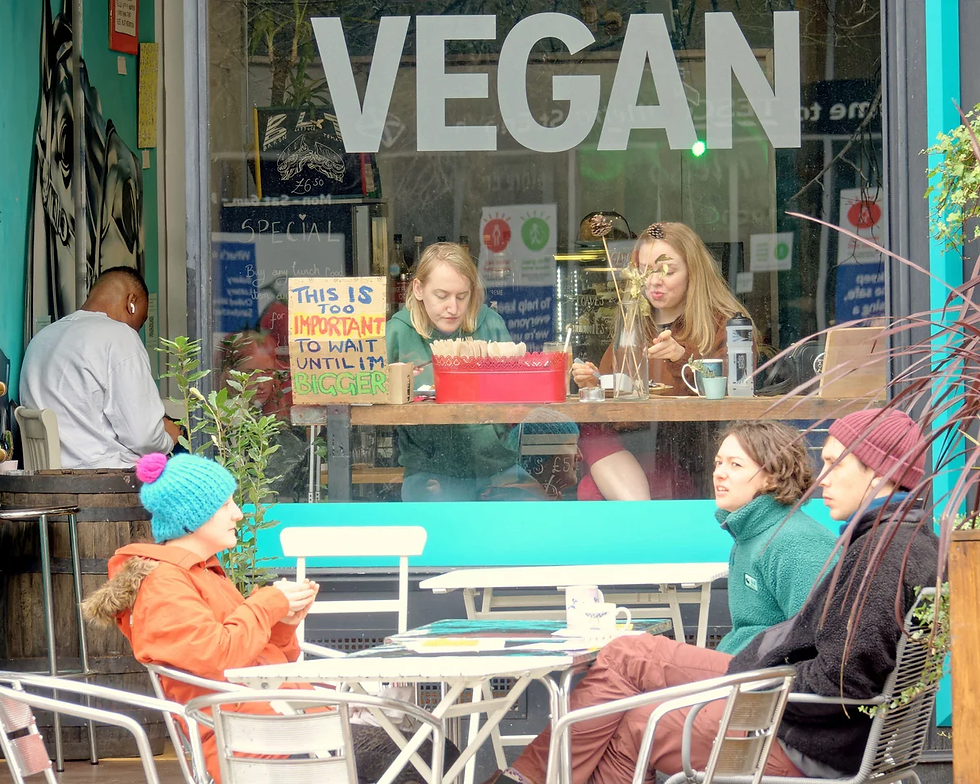Food: Plant-Based Whiplash: Why Vegan Venues Are Shuttering—or Sneaking Meat Back In
- InsightTrendsWorld

- Sep 2, 2025
- 5 min read
What is the Plant-Based Whiplash Trend?
Dual Reality: Interest in veganism keeps rising, yet many vegan restaurants and chains are closing or diluting their menus with meat.
Hospitality Squeeze: Cost-of-living pressures, wage rises, ingredient inflation, and energy bills are crushing unit economics—especially for independents.
Menu Mainstreaming: Omnivore restaurants now offer robust vegan options, siphoning price-sensitive mixed groups away from fully vegan venues.
Narrative Headwinds: Online debates about protein and “ultra-processed” foods have muddied perceptions of plant-based eating, even as environmental/health motivations grow.
Why it is the topic trending: Booming Demand, Breaking Business Models
Closures Hit Home: Beloved names shutter (e.g., Unity Diner’s near-death, Vurger Co’s wind-down), triggering visible community grief and online detective work.
Signal Moment: Eleven Madison Park’s decision to reintroduce meat—despite its celebrated plant-based pivot—reignites inclusion vs. principle arguments.
Data Dissonance: More people identify as vegan/plant-based and Veganuary participation is at record highs, yet venue viability lags.
Cultural Shift: Today’s plant-based success stories skew toward cuisines with deep tofu/soy traditions over “dirty vegan junk food” of the 2010s.
Overview: A Movement Growing Faster Than Its Restaurants Can Survive
Vegan eating is mainstreaming through omnivore menus and at-home choices, while specialist restaurants face an unforgiving cost and competition landscape. Emotional bonds within vegan communities amplify the sense of loss when venues close. The paradox: rising consumer appetite meets brittle operating models—producing a wave of shutterings and strategic pivots.
Detailed findings: What’s Actually Happening on the Ground
Unity Diner’s Rollercoaster: From planned liquidation to revival—Veganuary profits tripled a typical month; a Sunday roast carvery (with vegan Yorkshire puds) is now a key lifeline. Still “barely breaking even.”
Vurger Co’s Descent: Post-Covid inflation flipped basics—sometimes retail groceries beat wholesale prices; energy costs forced grills off during lulls, wrecking operations.
Sector-Wide Strain: Early-2025 UK saw ~20 hospitality closures per week; diners trade down, while operators shoulder higher NI/minimum wage and power bills.
Perception Wars: Social feeds amplify “ultra-processed” fears vs. “not enough protein” myths; both narratives erode confidence in plant-based formats.
Demand is Real: ~2M Britons identify as vegan/plant-based; Veganuary 2025 drew an estimated 25.8M participants worldwide.
Menu Migration: Tofu Vegan, Mali Vegan Thai, and chains like Wawin thrive—protein-forward, veg-first cuisines with authenticity and depth outperform novelty junk analogues.
Omni Competition: With solid vegan swaps across high-street brands, mixed groups default to cheaper, convenient omnivore spots—hurting specialist footfall.
Information Gaps: Some closures go silent (dead websites, phones), pushing consumers to user-led trackers; opacity undermines trust and harms the category.
Iconic Backtrack: EMP argues meat broadens the table; critics call it a values retreat. The flashpoint spotlights inclusivity vs. integrity tensions.
Key success factors of Plant-Based Whiplash (staying power, not just hype)
Protein-Credible Menus: Center tofu/tempeh/soy and veg craft over novelty analogues; make protein grams and satiation obvious.
Price Architecture: Tiered builds, value bundles, and day-part offers to compete with QSR “a fiver” benchmarks.
Operational Resilience: Energy-aware line design, smaller footprints, menu engineering to protect margins.
Community Flywheel: Memberships, pre-paid feasts, limited Sunday formats, and transparent financial updates to activate “team spirit.”
Discovery & Trust: Clear labelling (processing level, nutrition, sourcing), consistent hours, proactive closure/comms hygiene.
Key Takeaway: Demand Isn’t the Problem—Design Is
Consumers still want plant-based food. The venues winning are those that solve protein perception, price pain, and operational fragility—while harnessing community energy and cuisine credibility.
Main Trend: From “Vegan Novelty” to Protein-First, Price-Smart Plant Cuisine
A maturing market is rewarding everyday, culture-rooted plant cookery over stunt foods, with value, transparency, and reliability as non-negotiables.
Description of the trend: Plant-Based, Grown-Up
Menus shift from mimicry to mastery: less chasing perfect replicas of meat, more celebrating vegetables, soy tradition, sauces, and technique—delivered at prices and formats that fit real life.
Key Characteristics of the Core trend: Credible, Communal, Costed
Protein-Forward Clarity
Value-Engineered Menus & Dayparts
Cuisine Authenticity vs. Novelty
Operational Tightness (energy, labor, SKUs)
Community-Powered Revenue (events, roasts, memberships)
Market and Cultural Signals Supporting the Trend: Principles Meet Pragmatism
Participation Peaks: Record Veganuary; rising vegan/plant-based identifiers.
Wallet Reality: Persistent inflation → trading down, fewer dine-outs.
Omni Uplift: Mainstream menus normalize vegan choices anywhere.
Narrative Noise: Health myths and ultra-processed debates shape expectations.
Comeback Cases: Rapid reopenings (new sites/formats) prove demand can be reactivated.
What is consumer motivation: Values with Proof
Eat in line with climate/health values—without sacrificing protein, flavor, or price fairness.
Choose reliable venues; avoid uncertainty (erratic hours, surprise closures).
Seek community and ritual (roast carveries, set menus) that feel special yet affordable.
What is motivation beyond the trend: Belonging and Trust
Desire to be part of a cause that’s practical, not preachy.
Need transparent info to counter online confusion.
Preference for culturally rooted dishes that “belong” on the table, not just on social feeds.
Descriptions of consumers: The Pragmatic Plant-Leaner
Consumer Summary
Value-conscious, protein-curious, myth-sensitive, and time-pressed.
Loyal when engaged, but quick to defect if value or reliability slips.
Motivated by weekly rituals and shared occasions more than one-off hype.
Detailed summary (inference + article)
Who are they? Vegans, vegetarians, flexitarians, mixed-diet groups choosing the vegan option.
Age: Broad; strong 20–45 core.
Gender: Mixed; slight female tilt in discovery, broader mix in habitual dining.
Income: Lower- to middle-income urban consumers most price-sensitive; professionals seek dependable mid-week value.
Lifestyle: Health/planet-minded, but skeptical of UPF; want clear protein and satiety signals.
How the Trend Is Changing Consumer Behavior: Votes with Forks—and Wallets
Mixed groups default to omni venues with decent vegan picks.
Plant-based diners scrutinize labels, protein, and processing.
Fewer impulse meals out; more targeted, ritualized visits (e.g., Sunday roasts).
Social media mobilizes support—but can’t compensate for weak unit economics.
Implications of trend Across the Ecosystem: Plates, Prices, and Proof
Consumers: Expect flavor, fullness, and fairness; punish unreliability.
Brands/CPGs: Opportunity in transparent, protein-forward retail lines; recipe bases and sauces that travel from restaurant to home.
Restaurants: Shrink menus, deepen cuisine lanes, engineer contribution margins, anchor weekly rituals, communicate finances and hours clearly.
Suppliers/Energy: Partnerships for predictable pricing and efficiency retrofits become strategic.
Strategic Forecast: What’s Next
Protein Proof on Menus: Macros and satiety cues become standard.
Ritual Commerce: Carveries, set feasts, and membership nights stabilize demand.
Format Shifts: Smaller sites, pickup-first kitchens, limited hours to match demand curves.
Cuisine Consolidation: Growth in Asian plant-centric concepts; fewer “junk vegan” replicas.
Selective Flex: A minority of high-end venues add limited meat to widen party inclusivity; many others double-down on plant integrity with smarter value.
Areas of innovation: Five Launchpads
Protein-First Buildables: Transparent grams-per-bowl templates with tofu/tempeh, legumes, and sauces.
Ritualized Weekends: Plant-based roasts and banquet menus priced for groups, pre-booked to lock utilization.
Energy-Smart Kitchens: Induction lines, zoned equipment, and menu sequencing to cut peak power draw.
Trust Labels & Menus: Processing transparency icons, sourcing callouts, and macro badges to counter misinformation.
Community Capital: Prepaid dining passes, co-op memberships, and “founder tables” to fund runway and drive repeat visits.
Summary of Trends
Core Consumer Trend: Principle-driven eating seeking protein, value, and reliability.
Core Social Trend: Community identity around venues—grief at closures, mobilization at relaunch.
Core Strategy: From novelty to nourishment—engineer menus and ops for satiety and margins.
Core Industry Trend: Omni menus absorb casual vegan demand; specialists survive by owning rituals and authenticity.
Core Consumer Motivation: Align values with viable, tasty, and trustworthy everyday choices.
Final Thought: Make Plant-Based Make Sense
Plant-based dining hasn’t lost its audience; it’s lost margin and narrative clarity. Restaurants that foreground protein, price, and proof—while leveraging community rituals—can turn fragile passion into durable business. The mission hasn’t changed. The model must.





Comments